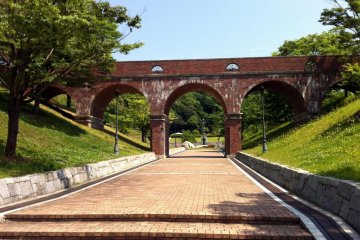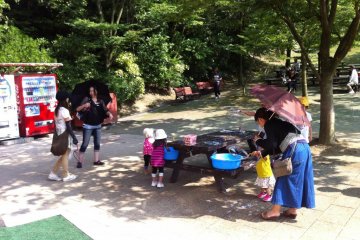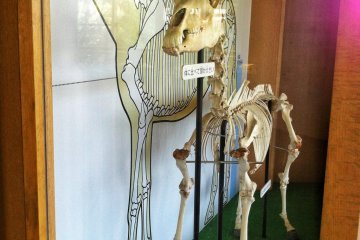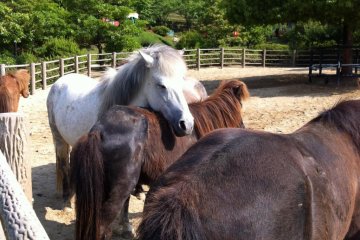Noma is the name of a farming area on the east side of Imabari. It’s also the name of a rare type of horse, the Noma-uma. The Japanese language doesn’t make distinctions between horses and ponies, but the Noma-uma would definitely be classified as a pony. From 1635 during the Edo Period, these horses were originally bred as war horses on Umashima (Horse Island), now one of the islands of the Shimanami Kaido. This plan didn’t work out due to illness and lack of food, so the horses were given to the peasants of Noma to raise. The feudal authorities paid them for the bigger horses that they raised, and the peasants got to keep the little ones, which interbred. The horses that are native to Japan are quite small anyway, but the Noma-uma is the smallest variety in Japan.
Noma-uma Highland is a facility for preserving the breed, but it also doubles as a tourist attraction. The ‘highland’ part refers to the fact that it’s set on the side of a hill. There are various dusty enclosure with horses in them, and visitors are free to touch the horses, which oblige by coming right up to the low fencing. There are also horse rides for children between the age of 4 and 11, which involve paying 200 yen, putting on a helmet and body armor, and sitting on a pony which is led around an oval enclosure by somewhat irritable staff. Don’t try to slip a two-year old past them because they won’t have it, and the two-year old will cry in disappointment. I know, because I observed a little experiment of this sort.
Nevertheless, there are other things that even two-year olds can enjoy. There’s a good children’s play area with a climbing wall, scramble nets, and slides, and there are little robotic animals that will walk around if you put money in them. The little ones can sit on the robots and steer them. There’s also an enclosure where children can cuddle rabbits and guinea pigs. The two-year old who I went with was quite alarmed to be handed a guinea pig and promptly threw it to me. Only my lightning-fast reflexes averted disaster.
There’s a visitor’s center offering various meals, snacks and souvenirs. On the second floor is a nice museum, which does a good job of presenting the history and uses of the Noma-uma. All the information is in Japanese, but the photos and graphics are generally self-explanatory. I found this very interesting.
When I went in early spring, there were few visitors and it was pleasantly quiet. We had a nice picnic in the open air, despite the cold. In the warmer months, they play awful music on a loop over loudspeakers throughout the park, which I could do without.
The horses themselves can be quite charming when they want to be. But they can also be utterly vicious at times, and there are signs around warning that they will bite and kick. When I went in spring, it was a bit like being in an X-rated movie, with all the sex and violence going on. The ponies are there to breed, and they don’t care where they get it on. They also kick the hell out of each to decide who gets first dibs.
If you’re in the area, and you like horses, and you’re not averse to what I’ve described, then I’m sure the horses will be glad to have your support. There may come a time in the not too distant future when working ponies will again prove their worth.
Name in Japanese
のまうまハイランド — Noma Uma Highland












